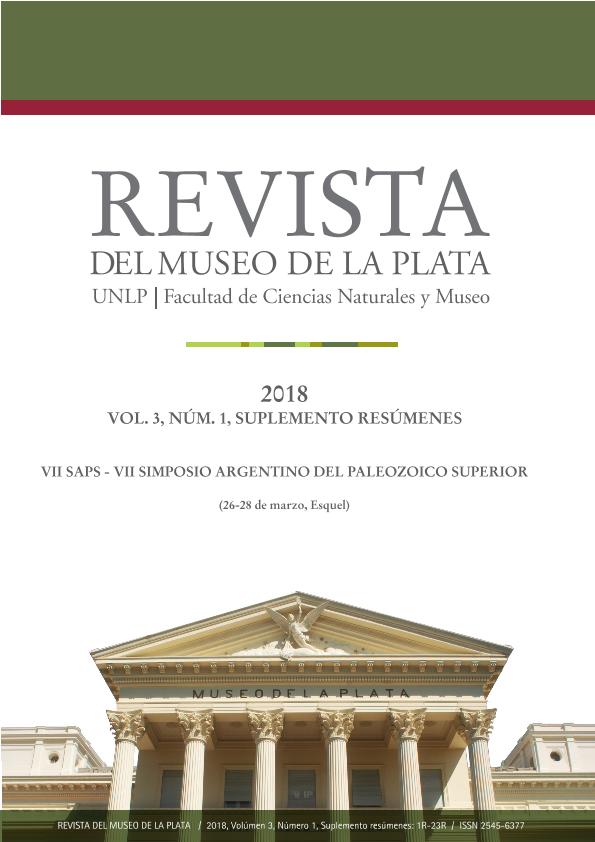Evento
Glaciation During the Late Paleozoic Ice Age
Isbell, John L.; Fedorchuk, N. D.; Pauls, Kathryn N.; Griffis, N. P.; Ives, L. R. W.; Moxness, Levi D.; Survis, S. R.; Vesely, F. F.; Montañez, I. P.; Limarino, Carlos Oscar ; Iannuzzi, R.; Biakov, A. S.; da Rosa, E. L. M.; Mundil, R.; Taboada, Arturo Cesar
; Iannuzzi, R.; Biakov, A. S.; da Rosa, E. L. M.; Mundil, R.; Taboada, Arturo Cesar ; Pagani, María Alejandra
; Pagani, María Alejandra ; Ciccioli, Patricia Lucia
; Ciccioli, Patricia Lucia ; Schencman, Laura Jazmín
; Schencman, Laura Jazmín ; Alonso Muruaga, Pablo Joaquin
; Alonso Muruaga, Pablo Joaquin ; Davydov, V. I.; Vedernikov, I. L.; McNall, N. B.
; Davydov, V. I.; Vedernikov, I. L.; McNall, N. B.
 ; Iannuzzi, R.; Biakov, A. S.; da Rosa, E. L. M.; Mundil, R.; Taboada, Arturo Cesar
; Iannuzzi, R.; Biakov, A. S.; da Rosa, E. L. M.; Mundil, R.; Taboada, Arturo Cesar ; Pagani, María Alejandra
; Pagani, María Alejandra ; Ciccioli, Patricia Lucia
; Ciccioli, Patricia Lucia ; Schencman, Laura Jazmín
; Schencman, Laura Jazmín ; Alonso Muruaga, Pablo Joaquin
; Alonso Muruaga, Pablo Joaquin ; Davydov, V. I.; Vedernikov, I. L.; McNall, N. B.
; Davydov, V. I.; Vedernikov, I. L.; McNall, N. B.
Tipo del evento:
Simposio
Nombre del evento:
VII Simposio Argentino del Paleozoico Superior
Fecha del evento:
26/03/2018
Institución Organizadora:
Centro de investigación Esquel de montaña y estepa patagónica;
Título de la revista:
Revista del Museo de La Plata
Editorial:
Universidad Nacional de La Plata. Facultad de Ciencias Naturales y Museo
ISSN:
2545-6377
e-ISSN:
2545-6369
Idioma:
Inglés
Clasificación temática:
Resumen
The Late Paleozoic Ice Age (LPIA) was one of Earth’s most extreme climatic events where sea level and biotic restructuring were driven by linked oscillations in the climate system. Despite an evolving understanding of the ice age, the size, distribution, paleogeography, timing, depositional settings, and possible bipolarity of the glaciation remains unresolved. However, new and refined radioisotopic age dates are revising the timing and extent of individual stages of the ice age. Recent studies suggest numerous, ice centers fluctuated diachronously as glaciation shifted across Gondwana. The LPIA began in the Famennian in northern South America and Africa and ended in eastern Australia during the Wuchiapingian. Although glaciation was widespread, numerous ice-free areas occurred adjacent to major glacial centers. Deglaciation was also diachronous beginning in the Bashkirian in western Argentina, shifting to the Paraná Basin by the end of the Pennsylvanian, with deglaciation of the South Polar Region occurring during the late Early Permian. Deglaciation culminated in eastern Australia with the disappearance of high, mid-latitude, alpine glaciers during the Wuchiapingian at a time when Polar Gondwana was ice-free. Recent work on diamictites in northeastern Russia indicates that these strata were not glacigenic but instead were deposited as volcanic debris flows and slides/slumps associated with concurrent activity in the Okhotsk-Taigonos volcanic arc. Therefore, bipolar glaciation cannot be confirmed. Although fluctuations in greenhouse gases were a major driver of climate, paleogeography, tectonism, and other minor drivers also played a role in the nucleation and disappearance of LPIA glaciers.
Palabras clave:
GLACIATION
,
PALEOZOIC
Archivos asociados
Licencia
Identificadores
Colecciones
Eventos(CIEMEP)
Eventos de CENTRO DE INVESTIGACION ESQUEL DE MONTAÑA Y ESTEPA PATAGONICA
Eventos de CENTRO DE INVESTIGACION ESQUEL DE MONTAÑA Y ESTEPA PATAGONICA
Eventos(IGEBA)
Eventos de INSTITUTO DE GEOCIENCIAS BASICAS, APLICADAS Y AMBIENTALES DE BS. AS
Eventos de INSTITUTO DE GEOCIENCIAS BASICAS, APLICADAS Y AMBIENTALES DE BS. AS
Eventos(SEDE CENTRAL)
Eventos de SEDE CENTRAL
Eventos de SEDE CENTRAL
Citación
Glaciation During the Late Paleozoic Ice Age; VII Simposio Argentino del Paleozoico Superior; Esquel; Argentina; 2018; 5R-5R
Compartir



